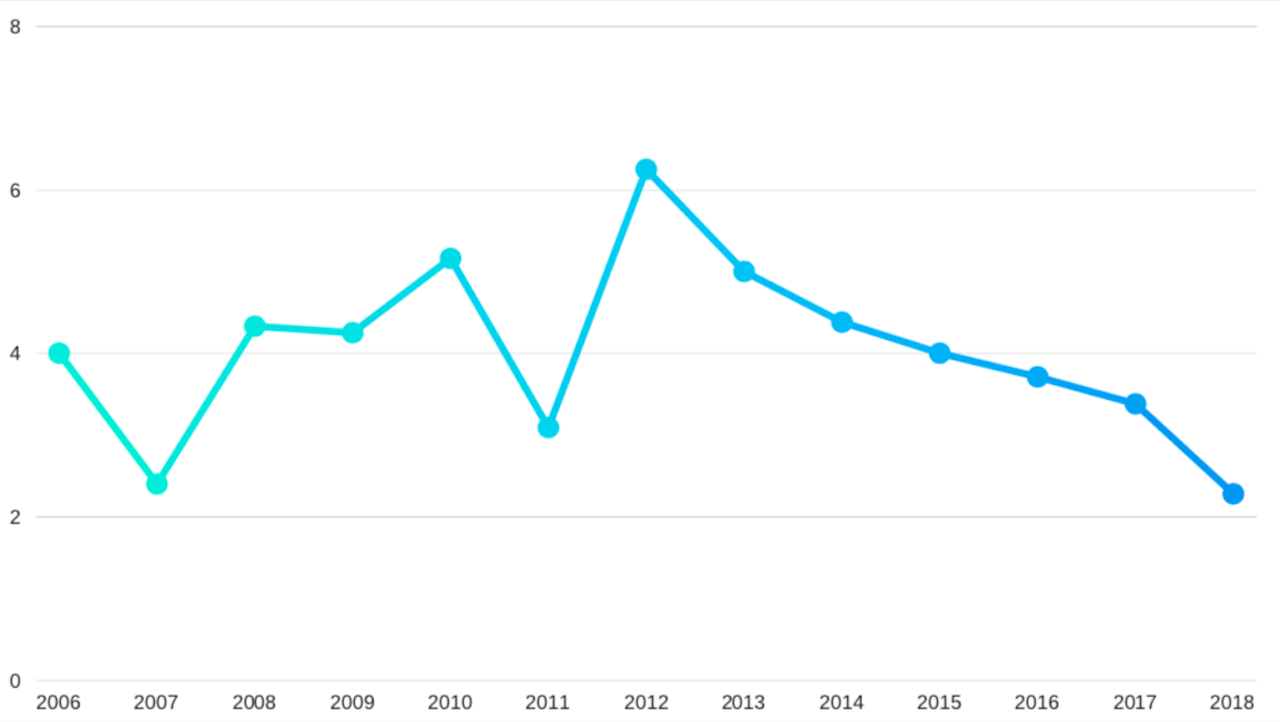ABSTRACT
There was a point in time when you could actually finish reading the internet each day. At least, it sometimes felt that way. Up until the late 2000s or so, it was possible to clear out all the new items in one’s RSS reader, and reach the end of all new content in a chronological social media feed. Now, feeds transcend space and time, offering an infinite scroll of atemporal content, with new posts appearing faster than can reasonably be consumed.
As this new content ecosystem developed, it was accompanied by the widely accepted notion of Meme Acceleration. That is, the number of memes is constantly expanding, while their average lifespans grow shorter. Memes live and die at ever-accelerating rates. While this feels subjectively true, it remains largely hypothetical. Are memes really moving at a faster rate? What is the average lifespan of a meme?
PRIOR STUDIES
I’m not the first person to attempt to quantify meme life cycles. One analysis from Cassandra Khaw in PCWorld reached inconclusive results. This was back in 2012, when memes were still crossing into mainstream popularity, so the study was perhaps too premature. Interestingly, CEO of The Cheezburger Network Ben Huh claimed in the piece that meme lifespans were “getting shorter and shorter,” suggesting that theories of Meme Acceleration have been with us for years. In 2017, Lauren Michele Jackson wrote an illuminating piece for The Atlanticabout meme death. Her analysis of three memes (Mr. Krabz, Bad Luck Brian, and Arthur’s Fist) indicates that their lifespans are indeed getting shorter, although the data pool was too small to definitively prove the hypothesis.
Additionally, the subreddit /r/memeeconomy offers a fake meme stock market, in which users “buy” and “sell” memes based on their projected values. Posts include “Diversify with this new rising stock, fresh from insider information” (speculating that a picture of a dude ripping open his shirt, Superman-style, to reveal a superhero costume with brain on the chest could become a popular meme format) and “Hot new investment, high risk — rapid normification danger” (linking to the image of Melania Trump in her monstrous “I Really Don’t Care, Do U?” jacket which has been poorly photoshopped to read “Pee is stored in the balls”). They’re often accompanied with the tags like “BUY BUY BUY” or “SELL SELL SELL.” No real money is invested. It’s all arch commentary, an elaborate waste of time (sort of like this article).
As far as I can determine, no one has attempted to do an extensive study of meme lifespans, nor to calculate their average lifespans.
METHODOLOGY, ANALYSIS, AND RESULTS
To properly measure memes, I needed a list of as many of them as possible, organized by year. Unfortunately, I couldn’t find anything like this anywhere online, so I had to create my own. After a long day of scraping through Know Your Meme, Wikipedia, and this incredibly helpful YouTube video, I created a long meme spreadsheet, which I titled An Incomplete Timeline of Memes, from 1946 to 2018.
It offers a good survey of ~12 years of internet memeing, allowing us to observe the development of their style and substance over time. Previous studies of meme evolution theorized that there were three epochs of memes — Unironic, Ironic, and Post-Ironic.
According to my timeline, however, it’s much more complicated than that. There are actually five distinct epochs: Proto-Meme (~1946-2005), which featured early, pre-social media memes like All Your Base and badday.mpg, along with pre-internet memes like Kilroy Was Here; The Golden Age of Meme (2006-2012), when social media thrust memes into widespread popularity, giving us Rage Faces and annoying, Impact font-heavy Advice Animals; Peak Meme (2012-2015) which gave us ironic memes, the corporatization of memes (aka “forced memes”) as seen in the Denny’s Twitter account, and horrible BuzzFeed-style clickbait, along with overly-earnest mainstream adoption, best exemplified in Minions content; and Post-Meme (2016-present), in which memes became surrealistic non-jokes, as well as cynically weaponized political tools.
Things I used to find funny: actual jokes
— memes (@DankMemePlug) September 4, 2017
Things I find funny now: pic.twitter.com/V2PNi3k7d4
Skimming through the list often feels cringy, kind of like looking awkward photos from middle school, especially now that the viral mania that made each popular has long-ago run its course. It’s hard to believe we ever found any of these interesting or funny. Still, it’s conceivable that in another decade or so, people might begin to feel nostalgic for them, or perhaps use them ironically, like Austin Powers references. This is all probably fine, they’re just harmless jokes, and at least digital trash culture doesn’t really create much material waste (except, I guess, for the piles of Grumpy Cat merchandise currently getting bulldozed into some big swampy pit in Florida), and only pollutes our tiny, gentle brains. To this I say: Yeah baby!!!
Once I had my meme timeline organized, I created a new document to measure the lifespans of each meme. This part was a little tricky and admittedly inexact. To gauge each meme’s popularity, I used data from Google Trends. I charted the “start” of each meme from the point they reached maximum popularity, or 100 on the Trends chart. Then I noted the number of months it took for its popularity to either reach equilibrium, fall to 0, or start a new viral cycle.
Regarding that last bit, I noticed that many memes seem to drop off in popularity before bouncing back later, though with slightly less total energy. They repeat this until losing all viral energy. Think of it like dropping a tennis ball and watching it bounce to a stop. So: I counted one cycle as a single bounce. That way, sticky memes that suddenly found a resurgence later, like “this is fine” in November of 2016 (see Fig. 1, below), wouldn’t artificially weigh down the averages.
I filtered out any items that didn’t have a clear spike in popularity and subsequent decay, and also any that would return overly broad results (for example, the “fuck yeah” rage face could refer to many things beyond that meme). This possibly tilts the results to focus on content that’s easily measurable, focusing on a certain kind of mainstream meme.
Anyway, I eventually ended up with a second, much shorter timeline. You can view and nitpick it here. According to my data, a meme lasts an average of about 4.017 months.
Charting out the average lifespan over the years (see Fig. 2, below), there is a clear a downward trend. As you can see, the average lifespan of a meme decreases. Memes are indeed moving faster.
POTENTIAL ERRORS AND POSSIBLE AREAS OF FURTHER STUDY
Of course, I don’t feel entirely comfortable saying these results are definitive, for various reasons, including: Google Trends is an inexact measure of popularity and doesn’t explore all meme distribution platforms in granular detail; the sample sizes are still too small; over the last 12 years, the total audience for memes has increased significantly, as has the total number of memes being created; the making/distribution of memes have also become more refined over the years; and I’m actually pretty bad at math (and overall a big dum dum), so I’m fairly confident I fucked a bunch of this shit up.
2018 culture is absolute, inescapable Baudrillardian self-regression pic.twitter.com/IPKcdFpZBz
— irl 🐙👨👦 (@charlequin) April 30, 2018
--
CONCLUSION
Despite all of these caveats, if my findings prove correct, and memes truly are accelerating, this has deeply disturbing implications. Already, the experience of spending any regular amount of time “online” is exhausting. We are astronauts, struggling to remain conscious in a speeding centrifuge of content. It will only get worse. Soon, memes may appear and die instantaneously. They will likely be incomprehensible, understood by everyone and no one simultaneously. Eventually, memes will consume and destroy all human knowledge and resources, and we will experience Meme Heat Death. Our reality will finally break apart, and a great blankness will devour our stupid universe.



